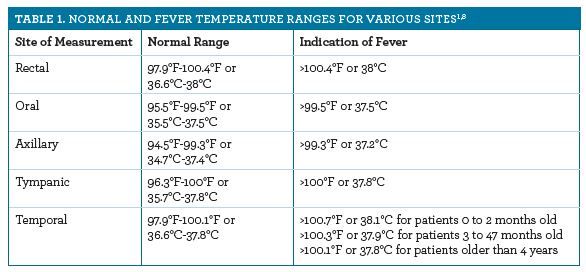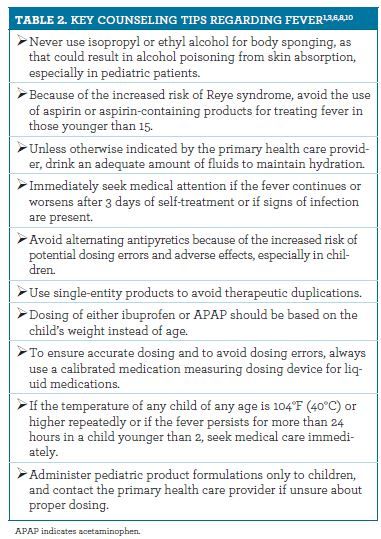Publication
Article
Pharmacy Times
Managing and Treating Fever: A Guide to Nonprescription Antipyretics
Author(s):
A fever is defined as having a body temperature greater than the normal core temperature of 100°F.
A fever is defined as having a body temperature greater than the normal core temperature of 100°F (37.8°C).1,2 Normal body temperature can fluctuate and average between 97.5°F (36.4°C) and 98.9°F (37.2°C).1-3 Fever is a very prevalent symptom that is often recognized as one of the chief causes of visits to the emergency department or pediatrician for patients younger than 15.1 Although most fevers can be easily managed with proper treatment, the presence of a fever may also indicate a serious underlying illness, such as an acute infection that requires immediate evaluation and treatment.1,2
A fever may be classified as idiopathic in nature, but it can also be the result of numerous factors, such as an infectious or pathologic process, a vigorous exercise, or a response to the use of certain pharmacological agents, also known as a drug fever.1-6 Examples of drugs associated with drug fever include certain anti-infectives (macrolides, penicillin, and tetracyclines), antineoplastics (bleomycin, daunorubicin, and hydroxyurea), cardiovascular agents (methyldopa, nifedipine, and quinidine), and central nervous system agents (lithium; serotonin and norepinephrine reuptake inhibitors; selective serotonin reuptake inhibitors; and tricyclic antidepressants).1 In general, most fevers are caused by microbial infections, including bacterial, fungal, and yeast infections.1,2,5 Fevers may also transpire after the administration of common childhood immunizations.3 Patients with fevers may also experience other signs and symptoms that can cause discomfort, such as arthralgia, chills, flushed face, a general feeling of malaise, headache, myalgia, and sweating.1-3
The occurrence of a fever is often a cause for concern for many patients and particularly for parents/caregivers of pediatric patients younger than 5. Pharmacists can assist patients and caregivers by educating them about the best measures to manage and treat fevers, including the proper use of nonprescription antipyretics.
Detecting Fevers
During counseling, patients should be advised to avoid feeling the forehead to check for a fever and instead use a reliable thermometer to obtain an accurate reading. Patients should also be advised to adhere to the manufacturer’s recommended procedures. Digital thermometers are the most extensively used measuring devices and are offered with an assortment of features that allow temperatures to be measured via axillary, oral, rectal, temporal, or tympanic routes.1,7 During an illness, the temperature should be measured with the same thermometer at the same site because readings from different thermometers or sites can vary (Table 1).1,8

The use of a rectal thermometer is the preferred method for temperature measurement in patients up to 3 months of age.1-3 The use of a tympanic thermometer is not recommended for those younger than 6 months of age because of the shape and size of the infant’s ear.1 Although measuring temperature rectally is preferred for those patients 6 months to 3 years of age, oral, tympanic, and temporal temperature measurement may be used in this patient age group if proper technique is used.1 In those patients older than 3, oral, temporal, and tympanic temperature measurement can be used.1
Treating Fever
The main goal in the self-treatment of fever is to relieve the discomfort commonly associated with fevers by reducing temperature to normal body temperature. However, it is important to also identify and treat the underlying cause of the fever.1,3,4 Nonprescription antipyretics and nonpharmacological measures are often used in the management and treatment of fever. Nonprescription antipyretics include acetaminophen (APAP) and nonsteroidal anti-inflammatory drugs, including aspirin, ibuprofen, and naproxen. APAP and ibuprofen are the 2 most extensively used antipyretics.1,5 Ibuprofen is approved only in patients 6 months and older for fever reduction.1 Antipyretics are available in a variety of formulations for adults and children as single-entity or combination products in capsules, chewable tablets, enteric-coated forms, extended- or sustained-release forms, gel capsules, liquid gels, liquids, rapid-release gel capsules, suspensions, and tablets. Acetaminophen is also available in suppository form for pediatric patients. Classically, the reduction of temperature and the alleviation of discomfort occur about 30 to 60 minutes after administration of antipyretics.1
Nonpharmacological measures, such as drinking fluids to prevent dehydration, maintaining a comfortable room temperature, and wearing lightweight clothing, should also be incorporated into treatment.1,3

During counseling (Table 2), pharmacists should confirm that caregivers and patients understand how to properly use antipyretic products, including dosing, administration, and possible adverse effects. Parents and caregivers should also be reminded to give children only those products that are formulated for children and to use appropriate measuring devices that accompany these products. Pharmacists should also screen for potential drug interactions and contraindications. Because antipyretics (Table 3) can also be found in many allergy, cold, cough, and flu products, patients should be advised to always read all medication labels prior to administration to avoid therapeutic duplications or possible medication overdose. Moreover, if patients and caregivers are unsure about correct dosing, especially for children, they should always contact their primary health care provider to avoid potential dosing errors. Caregivers and patients should be directed to always contact their primary health care provider immediately regarding fever if they have any concerns, especially if any of the following apply because they are examples of exclusions for self-treatment.1,3,8,9
- A child 3 months or older has a rectal temperature of 104°F (40°C) or higher.
- A child younger than 3 months old has a rectal temperature of greater than 100.1°F (38°C).
- A child 2 years or younger has a fever that lasts longer than 24 to 48 hours.
- The patient has a rash.
- The patient is exhibiting signs of infection.
- The patient refuses to drink any fluids and shows signs of dehydration, such as decreased urinary output and dry mouth.
- The patient is extremely irritable, sleepy, and weak.
- The patient shows signs of infection, such as severe ear pain or a sore throat.
- The patient has a stiff neck or is vomiting.
- The patient has a history of febrile or other kinds of seizures.
- The patient has diarrhea or a headache or is in extreme discomfort.
- The patient has immune system problems or other chronic medical conditions.
Table 3. Examples of Nonprescription Antipyretics
Products
Brand Names
Acetaminophen
- Children’s Tylenol Chewables
- Children’s Tylenol Oral Suspension
- Infants’ Tylenol Oral Suspension
- Little Remedies for Fevers
- PediaCare Fever Reducer & Pain Reliever
- Tylenol (Regular and Extra Strength)
Aspirin
- Bayer Aspirin
- BC Aspirin Pain Reliever Fever Reducer Powders
- Ecotrin 325 mg
Ibuprofen
- Advil Film-Coated tablets
- Infants’ Advil Concentrated Drops
- Advil Liqui-Gels and tablets
- Children’s Advil Suspension
- Children’s Motrin
- Infants’ Motrin
- Junior Strength Advil Chewables
- Motrin IB
Naproxen sodium
- Aleve
Miscellaneous
- BeKoool Fever Relief Soft Gel Sheets
Homeopathic/alternative remedies
- Homeolab USA Kids Pain and Fever Relief
Yvette C. Terrie, BSPharm, RPh, is a clinical pharmacist and medical writer based in Haymarket, Virginia.
References
- Feret BM. Fever. In: Krinsky DL, Ferreri SP, Hemstreet B, et al, eds. Handbook of Nonprescription Drugs. 18th ed. Washington, DC: American Pharmacists Association; 2015.
- Gould JM. Fever in the infant and toddler. Medscape website. emedicine.medscape.com/article/1834870-overview. Published September 13, 2017. Accessed December 29, 2017.
- Fever. John Hopkins Medicine Health Library website. hopkinsmedicine.org/healthlibrary/conditions/non-traumatic_emergencies/fever_85,P00831/. Accessed December 29, 2017.
- Fever in children: overview. PubMed Health website. ncbi.nlm.nih.gov/pubmedhealth/PMH0072639/. Updated November 17, 2016. Accessed December 29, 2017.
- Tunkel AR. Fever. Merck Manual Professional Version website. merckmanuals.com/professional/infectious_diseases/biology_of_infectious_disease/fever.html. Updated May 2016. Accessed December 29, 2017.
- Sullivan JE, Farrar HC. Fever and antipyretic use in children. Pediatrics. 2011;127(3):580-587. doi: 10.1542/peds.2010-3852.
- How to take your child’s temperature. Pfizer Consumer Healthcare website. childrens.advil.com/tips-resources/your-childs-fever/how-take-your-childs-temperature. Accessed December 29, 2017.
- Fever. nlm.nih.gov/medlineplus/ency/article/003090.htm. Medline Plus website. Accessed December 29, 2017.
- When to call the pediatrician: fever. American Academy of Pediatrics HealthyChildren.org website. healthychildren.org/English/health-issues/conditions/fever/Pages/When-to-Call-the-Pediatrician.aspx?nfstatus=401&nftoken=00000000-0000-0000-0000-000000000000&nfstatusdescription=ERROR%3a+No+local+token. Updated November 21, 2015. Accessed December 29, 2017.
- Fever without fear: information for parents. American Academy of Pediatrics HealthyChildren.org website. healthychildren.org/English/health-issues/conditions/fever/Pages/Fever-Without-Fear.aspx. Updated April 22, 2016. Accessed December 29, 2017.







